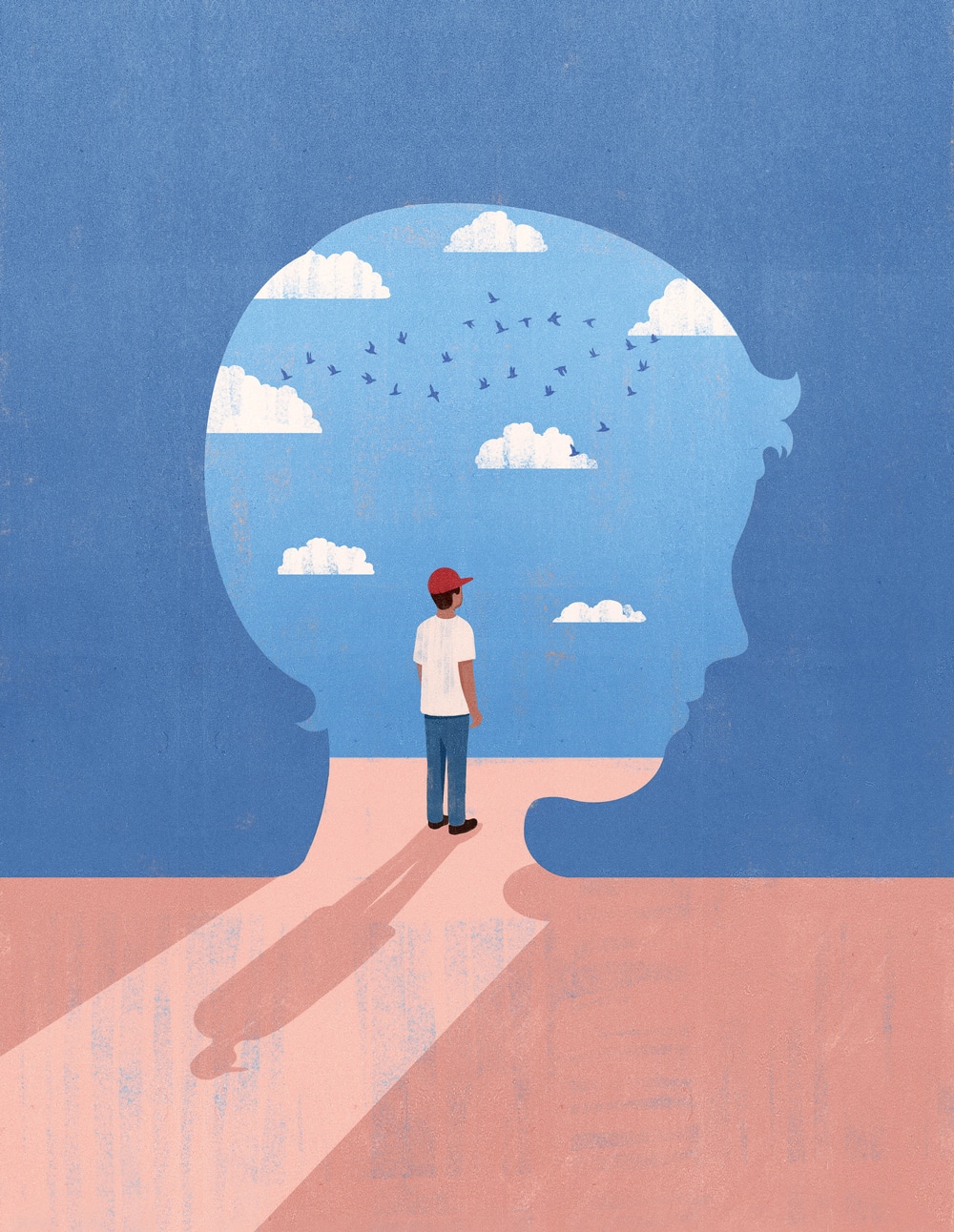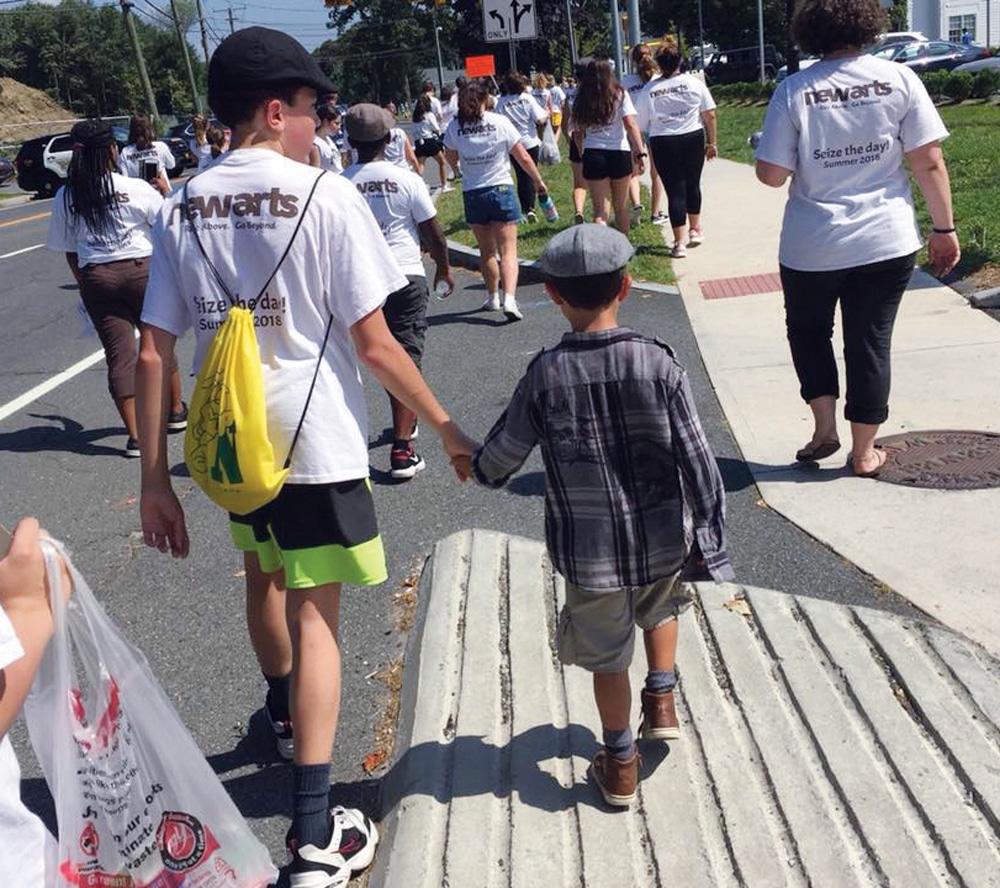Hope on Any Given Day
Twenty children lost their lives at a Newtown, Connecticut, elementary school in 2012. As the country moved on to mourn other mass shootings, survivors were left with their private wounds and memories.

Coffee By Design | Portland, Maine
Photo Credit : Katherine Keenan
What breaks my heart now about Sandy Hook is looking at pictures of my son, Tain, from that time and realizing how young he was when the mass shooting at his school occurred. It’s an odd trick of the mind, created by the fact that how he and I talk about the death of his friend Ben, one of the first graders killed that morning, is not so different from how we talked about it when Tain was 8.
Then: I feel like I’m going to see Ben again. He’s going to come down from heaven and he’s going to be here with all of us.
Now: When you think about it, Mama, we have more of Ben now than ever before. He is everywhere.
I’ll come across photographs and expect to see something of this maturity and wisdom represented, but instead I find an image of a boy with tired eyes at Ben’s funeral, clutching a stuffed puppy sent by friends; attached to his vest are the photos he asked for of him and Ben playing in leaves.
“How is Tain doing?”
This question sometimes pertains to the present, but it depends on who is doing the asking. A close friend may be referring to Tain’s transition into an arts high school, where he majors in theater, or to how he’s doing preparing for a musical. Others are talking about Sandy Hook, and I can only reply “Fine,” because I can’t address the myriad ideas of what they assume he might be.
He is all of those things. He is also none of them.
Tain whistles everywhere. The notes flutter from his breath and leave high-pitched streaks of joy across my heart like a jet streaming its white contrail across the blue, blue sky. At other times, like when he’s getting dressed for school, I can hear him singing—sometimes a silly song from one of his favorite cartoons, sometimes a tune from a musical he’s been in. One summer he was the scarecrow in The Wizard of Oz. In a photo from that show, he’s leaning on one elbow, the other arm perched on his bended knee. He’s just finishing “If I Only Had a Brain.”
I used to think that one day Tain might stop whistling and singing. I’d have to wonder what it meant, whether the silence of being a teenager had closed over him.
But he is not silent.
He cries when he needs to cry. He questions when he needs to question. He speaks out when he wants to speak.
After the 2018 shootings at Marjory Stoneman Douglas High School in Parkland, Florida, Tain’s middle school wouldn’t allow the students who wanted to protest gun violence to do so visibly. Their walkout took place behind a wall and out of public view.
Tain came home and complained. Although I have a sense of hopelessness about the gun issue, I told him there would be a march in Hartford, and he could protest there if he wanted. I have a photo of Tain at our dining room table, making his sign, a red octagon with black letters spelling out “STOP GUN VIOLENCE NOW,” and I have a photo of Tain and his friends from the next day, bundled up against the cold, holding their signs and standing on top of a wall so they could be seen.
Tain is 15 now. Recently, the mother of one of his friends sent me an email warning me that a Boy Scout merit badge project on researching our community might be emotionally difficult. She wrote, I just wanted to give you a heads-up in case Tain is sensitive about that. I responded with:
He’ll be OK with the presentation. The tragedy is a part of the tapestry of his life, and from the very beginning he surprised me by how willing he has always been to speak of it and engage with whatever goes on around it. I’m grateful for it.
I’m not sure if this was the right answer. I thought about not responding at all. It’s not that Tain isn’t sensitive. How do I explain the complex alchemy he generates that makes him able to hold the darkness and the light within him and carry on with living joy? How do I describe the way his big brown eyes look at the world and, miraculously, continue to perceive hope?
In her book Gravity and Grace, the mystic Simone Weil wrote, “Joy is the overflowing consciousness of reality.” Tain gets this.
There’s a photograph of Tain and me sitting in front of an audience at a bookstore in Manhattan. We’re being interviewed by Andrew McCarron, head of the religious studies department at Trinity School, about our book, This Child of Faith: Raising a Spiritual Child in a Secular World, the story of our family’s faith journey that began when we joined the Episcopal Church when Tain was 6.
Andrew read a portion from the end of our book in which I talk about my hope for Tain’s future faith. Then he asked Tain what his hopes were for my faith. After thinking about it for a bit, Tain said he hoped his faith would continue to inspire mine.
Tain spoke of the film Finding Neverland and how for the premiere of his play Peter Pan, J.M. Barrie had children from an orphanage brought in and seated them throughout the theater, because he knew the adults wouldn’t get the play unless they saw it through the eyes of children.
“It’s like that,” Tain said. “Young people are just more open. We look at things more positively. I hope I can always do that for her.”
I have learned a lot from Tain, but this in particular is a lesson I need the most. In fact, I think we all need it. As I get older, I feel deeply how the losses are mounting. Friends, family, classmates have died. I’ve attended more than half a dozen funerals and memorial services in less than two years, and I know this is only the beginning. What Tain offers is the alternative to living in a constant state of grief. There is something of the divine in how he moves through these hard times. This has happened, he seems to be saying. What can we make of it now?
He has lost family and friends so close they were like family. When my friend Katy, whom Tain always knew as Aunt Katy, was declining rapidly after a long battle with cancer, I made plans to rush to her bedside in New York City and almost didn’t take Tain. My grief was already consuming me. But then I realized he would never forgive me if I deprived him of the chance to say good-bye. He loved her too. The tears he got to cry were so important. To be able to say to her, “I’m going to miss you”—that was everything. In the weeks after the shooting she had taken him to the Big Apple Circus, and I have a photo of them wearing red clown balls on their noses, Katy’s blue eyes wide and goofy, Tain’s laughing.
A cousin, after an Ancestry.com experience, obtained photos from the early 1900s of my great-grandfather and his children, my grandfather included. From his birth date and the southern location it’s obvious his parents would have been slaves. I showed this to Tain on Juneteenth, when my eyes and ears were filled with social media mentions of generational trauma in one’s DNA and angry discussions of reparations. I wasn’t sure if I was handing Tain a time bomb. I showed him the picture, talked about our family’s connection to slavery. He looked at me and smiled quietly.
“We’ve come a long way, haven’t we?” he said.
I hadn’t even thought to think of it that way. I smiled in return and answered, “Yes.”
When I speak of Tain’s positivity, a friend says it’s obvious he gets it from me. And I have written about what it’s like to be a mother holding a space for a child, a space in which he can believe in life even after death has entered. But sometimes I feel my arms are too full of grief.
Now, it seems, Tain holds the space for me. He reminds me to trust.
There’s a photo of Tain sitting in front of a podium in a packed room in a church in Atlanta and showing no fear as he reads from a blog post he’s written. He’s wearing a jacket—green, white, and brown, modeled after a character in the video game The Legend of Zelda. The hood comes down to a long thin point on his back; the sleeves have laces on the shoulders and arms. He read, “I can always trust God to watch over my friends and family because I know he will always find a way to make things better.”
Tain likes public speaking, especially when he gets to talk to children. He enjoys signing books and traveling and meeting new people. He’s been to Marjory Stoneman Douglas High School. He knows he’s been able to do things other kids his age cannot. He also acknowledges the sad paradox of being grateful for these opportunities and yet:
“I’d rather have Ben back,” he says.
But that choice isn’t within reach; only the grief is. So we continue to craft a life from what is. There is no remembering, because there is no forgetting. There’s no reason to be concerned when the tears come, because that would be like denying the river running beneath our skin. And this is OK. We walk into the current again and again. Tain is now learning how to swim, but in these particular waters he is expert.
People who have read my work or heard me reference Sandy Hook still ask me where I live. They assume we’ve moved away. They were not there to see Tain’s tears when a panoramic shot of the Newtown skyline, with the Stars and Stripes billowing on the flagpole in the middle of Route 25, came onscreen during a documentary film, or to hear him say he was crying “because our town looks so beautiful.”
My husband and I are both from Ohio. Our parents never moved, so we know what it is to have a place in your veins, the same dirt always under your feet, streets that seem to need no names because you have walked, biked, driven them so often you knew where they led. It is a singular gift. I realized that Newtown is like that for Tain. This is his home. He knows no other. We would never willingly take it from him. Newtown is, for him, the Firehouse chicken sandwich from Misty Vale Deli, the eggs over easy from the Sandy Hook Diner, his favorite Japanese soda always stocked at Caraluzzi’s Market, the C.H. Booth Library across the street from our church, Trinity. It’s the $3 movies at Edmond Town Hall, the woods behind our house, the bike path around Fairfield Hills.
And it’s Ben’s grave.

Photo Credit : Courtesy of Sophfronia Scott
This summer, the mother of one of Tain’s friends died, a woman well known in our church and with whom I’d taught Sunday school. In the cemetery, at the end of her service, Tain asked, “Can we visit Ben’s grave?”
We went with another one of Tain’s friends, along with the friend’s mother, and it took a few moments to get our bearings. We were coming at it backward, from the other end of the cemetery, but we found it. Tain’s lanky teen-boy shape folded up as he sank to his knees in the grass before the stone and cried. The tears ran down in thin sheets, like rain buffeting a window in a long-awaited storm. He clasped his hands, his head bowed low. His lips moved silently, quickly, with urgency. The friend stood near him and waited. The friend’s mother and I waited. I looked away, because the moment felt too intimate and because I knew this is where important work is done. I was aware of not disrupting it.
Tain’s friend hugged him when he finally rose.
After leaving Ben’s grave, I remind Tain he can return as often as he wants. Something tells me knowing that is enough for him. I’m curious how long it will be before he goes back. As he has said, Ben is everywhere.
I think of another photo. In this one, Tain is walking down the street after marching with his theater group in Newtown’s Labor Day parade. He’s holding the hand of a small boy who was also in the group. In a strange yet miraculous and beautiful way, this image represents a huge part of who Tain is and will continue to be: a person growing older, but always accompanied by a 6-year-old who will never age another year.








Such beautiful sentiments Sophronia, Tain is a true inspiration as are your words. Tears here, tears of amazement and memory and healing. Thank you for “holding a place” for all who read this. Your perspective helps all in our community. Hugs to you and Tain!❤️
Thank you Sophfronia for sharing this beautiful, moving and hopeful essay with us. May you continue to find strength and hope through Tain, and he from you, and may Ben’s memory forever be a blessing to you both and to all who knew him.
This is a truly wonderful and inspirational story especially in this difficult time. May all who read it be comforted by the knowledge that there can be Hope On Any Given Day for everyone who has lost a loved one.
Sophfronia you and Tain are such brave and courageous souls. My daughter lost three students from that school. I am sending her your story. May God keep you and Tain in the palm of His hand always.
Dear Tain
Hi it’s Mrs Gunn. Just read your mom’s story. I am so proud of you and the work, love and compassion you give to make this a more beautiful world.
xoxo love Mrs. Gunn